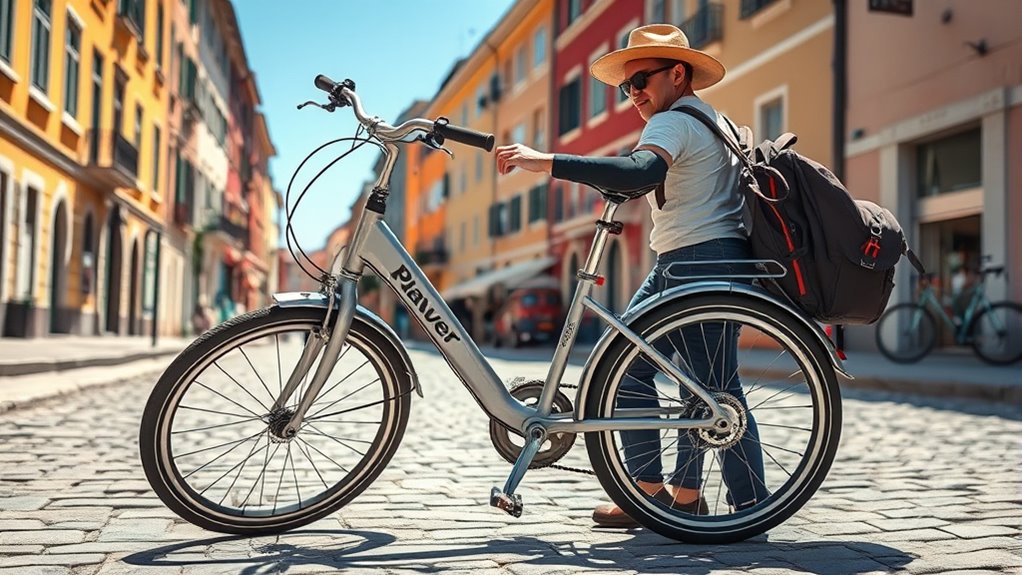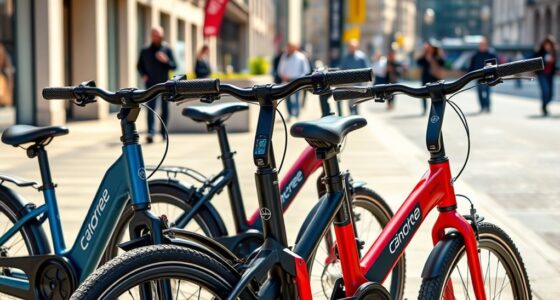Traveling with a folding bike makes multimodal commuting easier and saves you money. To prepare, remove pedals, slightly deflate tires, and secure loose parts with padding or insulation. Pack it in a sturdy bike bag or case, following airline size and weight limits, and check policies beforehand. Use carry-on options like a Brompton for convenience. Keep safety tips in mind to avoid damage or extra fees—if you want to learn more, you’ll find practical tricks to streamline your trip.
Key Takeaways
- Disassemble and securely pack your folding bike with padding to prevent damage during transit.
- Check airline policies on baggage size, weight, and folding bike regulations before traveling.
- Use high-quality bike bags or cases designed for airline travel to protect your bike.
- Slightly deflate tires and secure all moving parts to minimize risks during handling.
- Label your bike as fragile and handle it with care during check-in, transit, and storage.
Benefits of Traveling With a Folding Bike and Multimodal Commuting
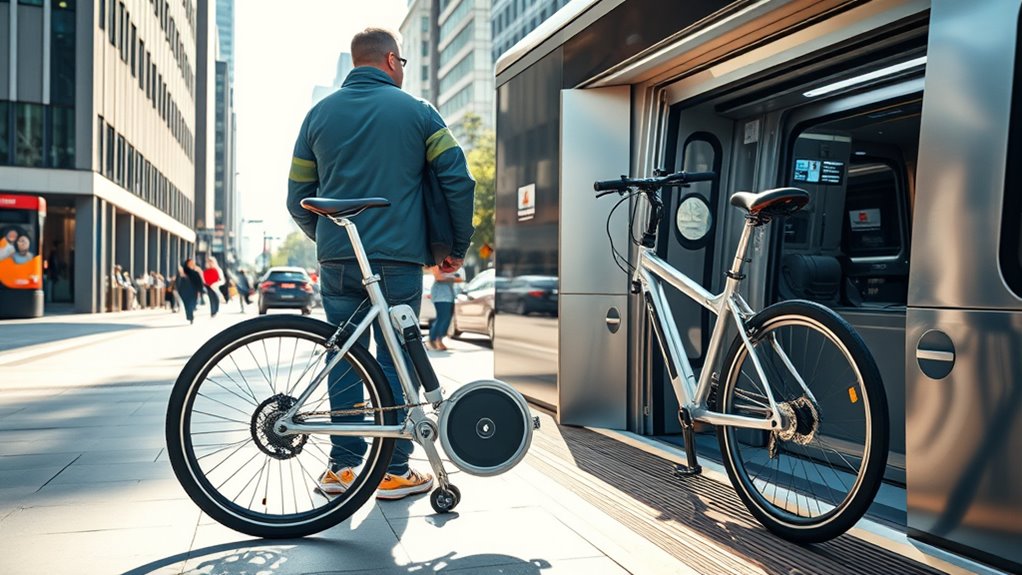
Traveling with a folding bike makes multimodal commuting more convenient and flexible. With folding bikes, you can seamlessly switch between buses, trains, and airplanes, reducing reliance on taxis or public transit. Their compact fold allows you to use them as a bike carry-on, fitting easily into airline baggage policies, saving time and hassle. This travel flexibility lets you explore narrow streets and local attractions, enriching your trip experience. Lightweight and easy to pack, folding bikes simplify transfers and luggage handling, making your journey smoother. Plus, they encourage active exploration and healthier routines, giving you the freedom to spontaneously discover new places without extensive planning or renting cars. Additionally, the ability to carry and store your bike easily can enhance your overall travel experience, making every aspect of your journey more enjoyable. The versatility of folding bikes also supports urban mobility, and helps reduce your carbon footprint while traveling. Incorporating sustainable transportation options like folding bikes can significantly decrease your environmental impact during trips. Moreover, their adaptability to various terrains allows for more diverse exploration, expanding the range of adventures you can undertake. Using folding bikes can also help you stay consistent with your fitness routines, even while traveling. Overall, folding bikes enhance your travel versatility and enjoyment, no matter your destination.
Packing and Preparing Your Folding Bike for Air Travel

Proper packing and preparation are essential to guarantee your folding bike arrives safely and intact. You’ll want to use the right tools and techniques, like removing pedals and securing parts, to make packing easier. Let’s go over a checklist to help you pack efficiently and protect your bike during air travel. Incorporating proper packaging materials can further safeguard delicate components and prevent damage during transit. Additionally, understanding tuning options for your bike can help optimize its performance and durability during your trip. Using high-quality professional-grade packing supplies can also extend the protection your bike receives in transit. Considering bike-specific accessories can additionally improve packing efficiency and safeguard critical areas of your bike. Being aware of Mazda Tuning techniques can also inspire ways to maintain your bike’s condition during long journeys.
Packing Techniques and Tools
To pack your folding bike for air travel, start by removing the pedals with a wrench to make the bike more compact and prevent damage. Next, slightly deflate the tires to avoid punctures, since cargo holds can handle external pressure changes. Rotate the handlebars to be parallel with the frame and secure all loose parts to maximize protection and packing efficiency. Use protective components like foam padding or pipe insulation on hinges and vulnerable areas. Place the bike into a suitable bike bag, hard case, or suitcase that meets airline size and weight limits. This ensures proper protection and avoids extra fees. Additionally, consider the transportation policies of the airline to ensure compliance and smooth travel. It’s also advisable to check for special packing requirements for sporting equipment to prevent issues at the airport. Understanding home decor options such as wall organization and protective packaging can help in preparing your bike for travel and storage. Incorporating professional packing techniques and customized padding can further minimize the risk of damage during transit.
Packing Checklist and Tips
Before packing your folding bike, double-check that all loose parts, such as pedals, handlebar grips, and accessories, are removed to minimize size and prevent damage. When preparing for travel, make sure your folding bike is securely packed into compliant baggage, a hard case, or its original box that meets airline size and weight limits. Slightly deflate the tires to prevent bursting during transit, and secure all moving parts with foam padding, pipe insulation, or rubber bands to avoid shifting. Use protective covers like a Brompton Bike Cover or Dimpa bag to shield your bike from dirt and scratches. Additionally, automation in logistics can help track and manage your bike’s transport more efficiently. Proper packing can also help prevent potential damage during transit, making your travel experience smoother and safer for your folding bike. Always check airline policies before check-in to avoid surprises, and remember that proper packing can make your travel experience smoother and safer for your folding bike. Being aware of airline restrictions can further prevent issues during boarding.
Checking and Handling Your Folding Bike With Airlines
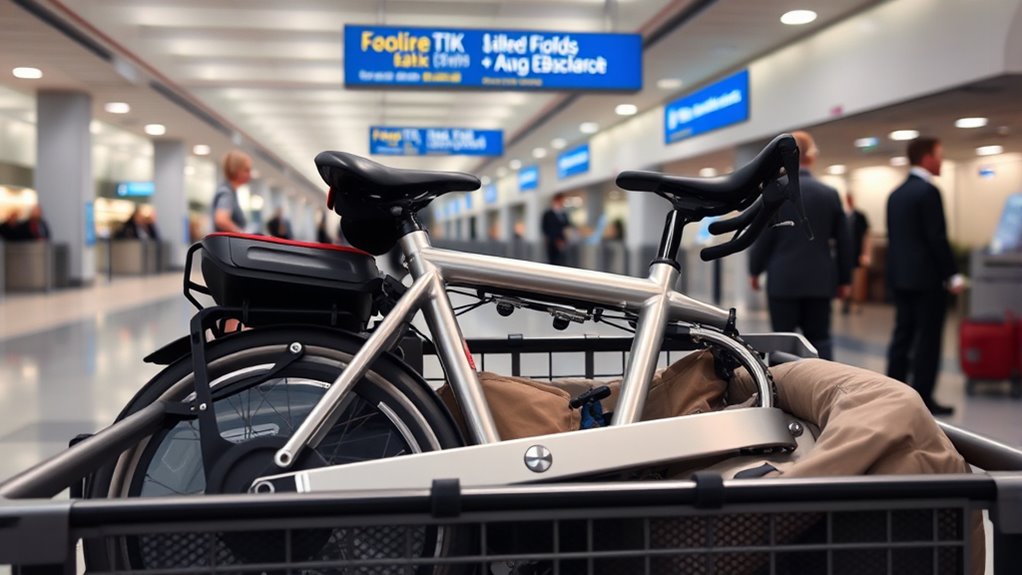
When taking your folding bike on a flight, it is vital to understand airline policies to avoid surprises at check-in. Most airlines allow folding bikes as checked luggage, but fees and size restrictions vary. To guarantee smooth handling, follow these tips:
- Confirm airline baggage allowance and specific policies beforehand.
- Pack your bike in its original box or a sturdy case to meet size restrictions.
- Thoroughly fold your bike, removing pedals and securing parts.
- Check if gate check is available or if you need to check-in at the counter.
- Be aware of newborn safety guidelines to ensure your travel environment remains secure for your journey. Additionally, review the electric bike regulations for specific airline policies concerning battery types and capacities. It’s also helpful to familiarize yourself with sustainability practices that airlines may implement, which can affect your travel plans.
Being aware of these guidelines helps prevent extra fees or delays. Remember, adhering to airline policies on weight, dimensions, and packing makes traveling with your folding bike hassle-free.
Carry-On Options and Using a Brompton as a Carry-On
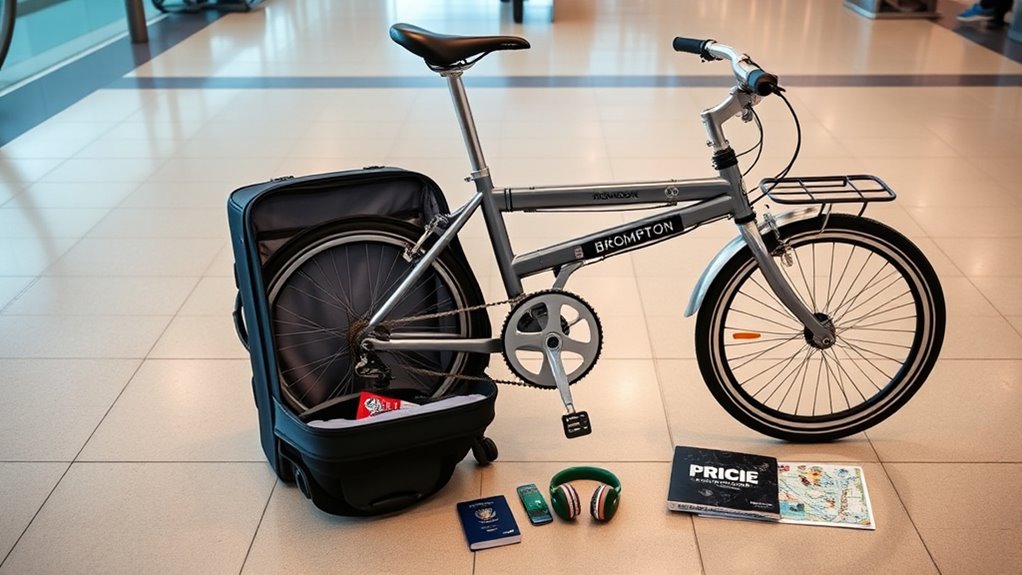
Many travelers find that carrying their Brompton as a carry-on offers the convenience of avoiding airline baggage fees and handling issues. With a folded size of about 23 x 22.2 x 10.6 inches, your Brompton fits easily into most carry-on compartments. Using a dedicated travel bag and cover protects the bike during transit and speeds security checks. You can attach it to a lightweight bag for easy airport transport or fold it just before security to streamline the process. Always verify size restrictions and early boarding options with your airline. Proper preparation guarantees a smooth experience, whether gate-checking or carrying onboard.
| Feature | Benefit | Tip |
|---|---|---|
| Folded size | Fits in airline baggage compartments | Measure before travel |
| Travel bag & cover | Protects during security checks | Use a Brompton-specific cover |
| Gate check option | Avoid handling damage | Confirm airline policies |
Tips for Packing Your Folding Bike to Minimize Fees
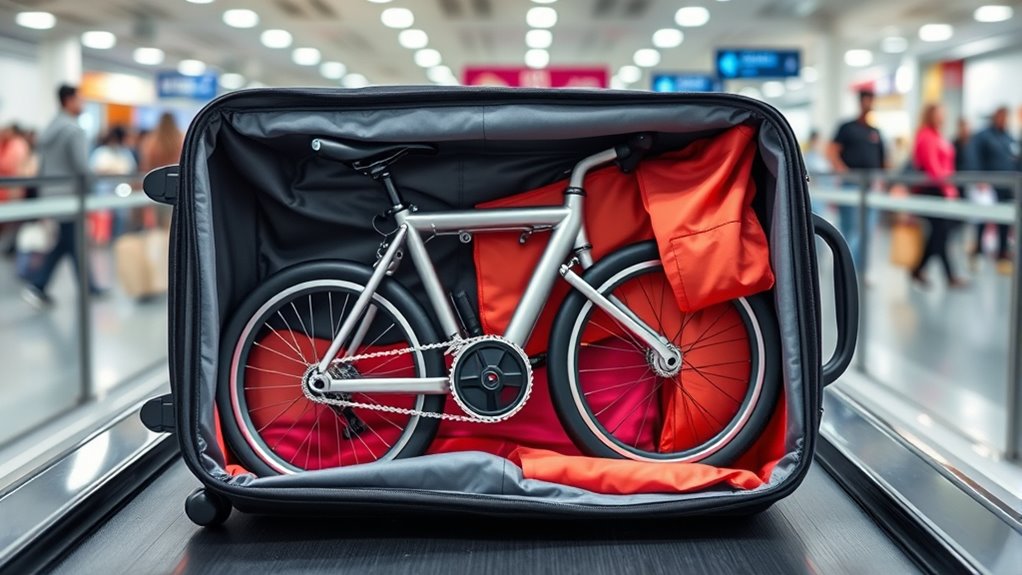
To keep your folding bike’s fees low, use proper packaging materials like original boxes or a standard suitcase to avoid extra charges. Make sure to remove pedals, deflate tires, and fold handlebars tightly to stay within size and weight limits. Packing it discreetly as regular luggage helps prevent security issues and additional fees.
Use Proper Packaging Materials
Using proper packaging materials is essential to protect your folding bike and keep baggage fees in check. Choose original bike boxes or padded bike bags that meet airline size restrictions to ensure secure packing and avoid oversized fees. To maximize bike protection, add protective padding like foam or pipe insulation around delicate parts. Wrap the frame and sensitive areas with bubble wrap or foam padding for extra impact resistance. Secure all loose components with zip ties or rubber bands to prevent movement during transit. When packing, deflate tires slightly and rotate handlebars to reduce dimensions. Label your package clearly as “Fragile” or “Handle with Care” to encourage careful handling, ensuring your bike arrives safe and with minimal fees. Proper packaging makes all the difference.
Pack in Original or Standard Luggage
Packing your folding bike in its original box or a dedicated bike case is one of the best ways to avoid oversized baggage fees. Most airline baggage policies allow boxes up to 70 inches in combined length, making a bike case or original packaging ideal. Proper packing involves disassembling your folding bike, removing pedals, deflating tires, and securing moving parts to maximize space and prevent damage. Using compliant luggage, like a sturdy bike case or a large suitcase, helps keep your bike within the airline’s baggage allowance, reducing the risk of extra charges at check-in. Ensuring your folding bike fits within weight limits—usually around 50 pounds—further minimizes fees. Packing carefully and in suitable luggage streamlines check-in and keeps your travel hassle-free.
Best Practices for Safe and Secure Packing
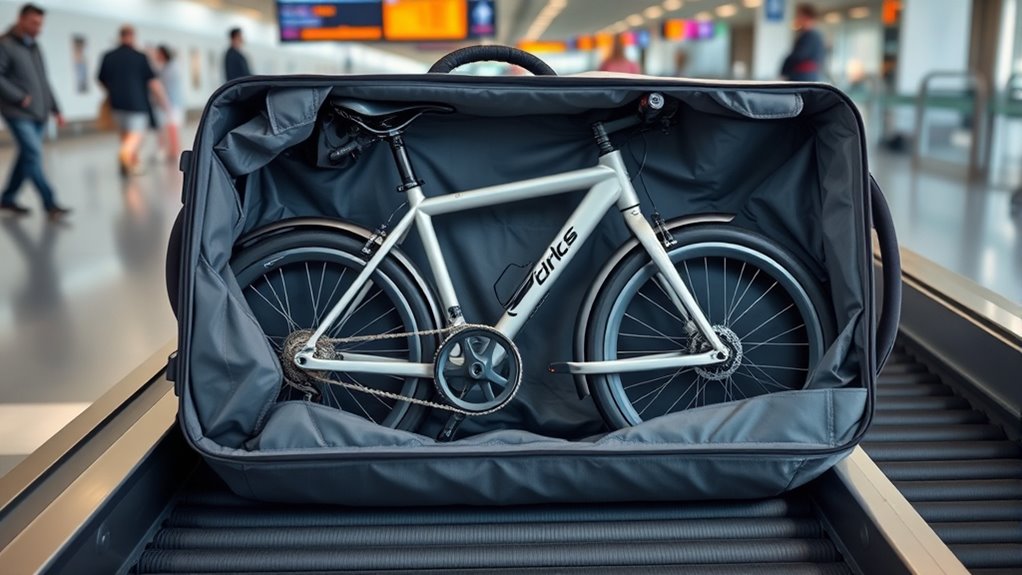
When preparing your folding bike for travel, guaranteeing it’s packed securely and safely is essential to prevent damage and delays. Use a sturdy, padded bag, hard case, or specially designed suitcase to protect your bike during transit. Remove pedals, handlebar, and loose components, then secure all parts to prevent movement. Wrap sensitive areas like hinges with pipe insulation and secure with rubber bands to cushion impacts and avoid scratches. Attach clear “handle with care” or “fragile” labels to alert handlers to treat your bike gently. Make sure your packing stays within airline size limits (usually 62 linear inches) and weight restrictions (around 50 lbs) to avoid extra fees or confiscation. Proper packing minimizes damage risks and ensures smooth travel with your folding bike.
Regulations and Size Limits for Public Transit and Car Travel

To travel smoothly with your folding bike on public transit or in a vehicle, it is vital to be aware of size restrictions and regulations. Many public transit systems require folding bikes to be fully folded at all times during travel. The standard size limit for folding bikes on MRT and LRT systems is 120cm x 70cm x 40cm, which you must maintain when folded. Buses typically allow only folded bikes that fit within specific size constraints, usually permitting one bike per trip. For car travel, be mindful of baggage restrictions, as airlines often enforce size and weight limits for folding bikes, with typical checked bag dimensions around 62 linear inches. Proper bike packing guarantees compliance, avoiding extra fees or confiscation.
Strategies for Gate Checking and Overhead Storage

Gate checking your folding bike can be a convenient way to avoid bulk in the cabin, but proper preparation guarantees it arrives safely. To guarantee your bike’s safety during gate checking and overhead storage, use a protective bag designed for folding bikes, and secure hinge clamps and pedals with foam or pipe insulation. Remove the saddle, loosen the handlebar clamp, and tilt the bars inward to meet size restrictions for overhead compartments or cabin carry-on. Attach a “handle with care” sign and place your bike in a transparent Dimpa bag to reduce mishandling. Keep these tips in mind:
- Use a protective bag for gate checking
- Secure moving parts with foam or insulation
- Remove saddle and adjust handlebar for overhead storage
- Mark your bike with a “handle with care” sign
Community Resources and Support for Traveling Cyclists
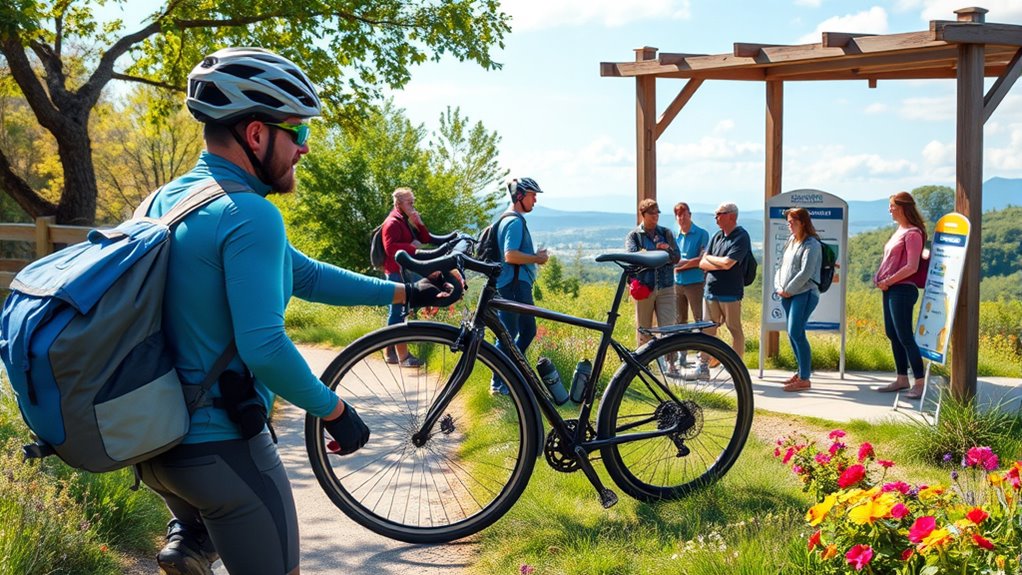
Community resources and support networks play an essential role in helping you navigate the challenges of traveling with a folding bike. These networks offer valuable community support, connecting you with fellow cyclists who share experiences and advice. You’ll find exhaustive folding bike guides, instructional videos, and articles that cover airline policies, security checks, and packing tips, making your journey smoother. Online forums and cyclist networks allow you to ask questions, exchange tips on airline regulations, and learn best practices for packing your bike securely. Support organizations like Campfire Endurance provide personalized coaching and training programs, both locally and nationwide. Donations and community contributions help expand these resources, ensuring you have access to expert guidance and a strong support system for your long-term cycling adventures.
Frequently Asked Questions
Can You Bring Folding Bikes on a Plane?
You can bring your folding bike on a plane, but it depends on the airline’s policies. Most airlines allow checked or carry-on options if your bike folds compactly and fits within size limits, like Brompton’s 23 x 22 inches. Be prepared for possible fees up to $150 per leg. Always verify with your airline beforehand, and pack your bike properly to avoid security issues or extra charges.
What Is the Disadvantage of a Folding Bike?
You should know that a folding bike has some disadvantages. It often has smaller wheels, which can make it less stable and comfortable, especially on rough terrain or at high speeds. Its frame might be less rigid, leading to a less efficient ride. Plus, lighter construction means it could be less durable and more prone to wear and damage over time. Frequent folding can also cause wear on hinges and joints, requiring maintenance.
How to Carry a Foldable Bike?
To carry your foldable bike, first check your airline’s policies for size and weight limits. Remove pedals, deflate tires, and secure all parts to prevent damage. Use a protective cover, soft case, or original box for extra safety. For convenience, fold your bike to its smallest size, then carry it onto the plane as carry-on if it fits in overhead compartments or under the seat, ensuring a smooth travel experience.
Are Folding Bikes Good for Long Rides?
Folding bikes can be great for long rides if you choose one with larger wheels, like 24-26 inches, for better stability and efficiency. Make sure it has high-quality components and a comfortable fit to reduce fatigue. Regular maintenance and upgraded tires also help improve performance. With the right setup, you’ll enjoy smooth, extended rides just like on a standard bike, making folding bikes a versatile choice for long-distance cycling.
Conclusion
Traveling with a folding bike opens adventures beyond the horizon, much like Alice stepping through the Looking Glass. With smart packing, airline tips, and transit strategies, you’ll navigate new places confidently. Embrace the freedom of multimodal commuting and community support, turning every trip into a story worth telling. So, gear up and pedal forward—your journey awaits, and the world is your whimsical Wonderland.
